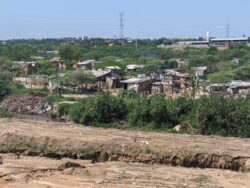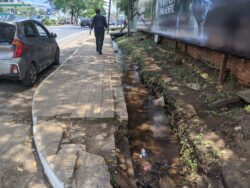Asuncion: Booming Population, Porous Infrastructure
The Paraguay capital’s growth is exposing the flaws of public utilities, but the promise of private replacements.
Asuncion, the capital of Paraguay, has some of Latin America’s worst infrastructure. It’s a city, in rich and poor areas alike, of dirt roads, broken sidewalks, and sewage-filled creeks. Some of this is inevitable from such a poor society—a sort of “poverty as default”. But much of it owes to the mismanagement inherent in government-run infrastructure, and as I noted while visiting, there are good private alternatives.
Asuncion’s infrastructure hasn’t kept up with its rapid growth. Population has roughly doubled since 2000 to 3.5 million, and Paraguay overall, like much of the Third World, is fast-urbanizing due to people escaping rural poverty. This creates problems the city isn’t ready for.

According to Urban Resilience Hub, less than 20% of areas “critically vulnerable to flooding” are covered by Asuncion’s drainage system. It’s in a flood-prone region to begin with, with mass dislocation dating back decades. I found while touring that people tend to build informal settlements, called banados, in flood zones near the river, since they can’t afford to live on pricier elevated land.

Even when such neighborhoods don’t flood, lack of drainage leads to huge road puddles from normal rains. Because roads aren’t paved, it makes for a muddy mess. An example I saw was in the San Antonio slum, just outside the city center.
This is a diversion even from the slum settlements I visited elsewhere in LatAm (called favelas or barrios populares depending on the country). As you’ll recall from my article weeks ago, ones in Brazil, Argentina and Colombia have paved roads. But in Asuncion, a fifth of residents live in neighborhoods like San Antonio.
Even in nicer neighborhoods, I found there were limited to no sidewalks. They were often patchwork, put together by separate property owners.
These relatively minor examples of infrastructural breakdown speak to more serious issues. For example, Paraguay’s water is polluted. Even where I stayed in Villa Morra, one of the nicest areas, a creek stunk up its surroundings with raw sewage.
“The infrastructure gap and lack of comprehensive urban water management has led to the contamination of urban rivers and streams, the bay of Asuncion and wetlands,” Urban Resilience Hub concludes. The aforementioned poor drainage, along with destroying roads, increases erosion into these waterways.
The World Bank notes that just 15% of Paraguay’s urban residents have sewer access, and less than half of rural residents are connected to a water network. While Asuncion has centrally-managed water, it is not clean enough to drink.
Lastly, the city has a mosquito problem, without the requisite pest control measures to solve it. In some neighborhoods they are so common as to make life miserable.
All these failures are unsurprising given Paraguay’s poverty—per capita income is under $6,000 USD—and from a certain vantage they can’t even be called “failures.” Developing societies don’t have the resources to provide First World infrastructure.
But to an extent putting this infrastructure in government management—with its corruption, disregard of the commons, and other public choice flaws—is the problem. We can tell by looking at the track record of privately-managed Third World infrastructure.
For example in Honduras, the public road system is arguably in worse shape than in Paraguay. But CA5, a public-private road partnership that cuts through the country’s urbanized spine, is smoother than most U.S. interstates. Other examples of successful public-private partnerships abound throughout Africa and LatAm.
The most extreme example comes in LatAm’s many private planned communities, some of which I’ve come to call “startup cities”. They often handle internally many of the utilities that surrounding governments fail at: clean water, sewage control, policing, generator-powered electrical backup, etc. (Of course, cost-of-living is higher within such projects for this reason, meaning the model isn’t scalable to all citizens).
While not a startup city per se, a local conglomerate is building a major private development in Asuncion called Distrito Perseverancia. It will provide a number of these services and amenities, and, tellingly, is going in a part of the city marked by vacancy.
Asuncion has many more of these projects going up with internal private management. Another upscale one that I saw, Paseo la Galeria Mall, was like a mini-paradise of tropical landscaping, air conditioning and private security. But walk a block outside and you’re back to broken sidewalks and spotty drainage.

There are efforts to improve Asuncion’s public infrastructure, with civic works underway for the port, public spaces, bus rapid transit, housing, and a bridge across the river into Argentina. One revitalization project seeks to mitigate a specific banado’s exposure to weather events.
But a major challenge is that Paraguay’s public governance is replete with corruption. The country was under oligarchic control into the late 1980s, under a regime which “‘institutionalized’ corruption,” according to a 2004 report by the Americas’ Accountability Anti-Corruption Project. Even this year, the sitting vice president and a former president were accused of participating in a bribery scheme and aiding the terrorist group Hezbollah. Transparency International claims the country is 28th most corrupt in the world (in the early 2000s, it was 4th).
As the country keeps urbanizing, it seems better infrastructure will sooner come from the private sector. Paraguay should strengthen a framework of laws and property rights, encouraging companies to offer their own services. Even if that just leads to various scattered, isolated real estate projects, it still offers a competitive governance framework for the average Paraguayan to choose from.
All images credited to Scott Beyer and The Market Urbanist.
Catalyst articles by Scott Beyer | Full Biography and Publications
